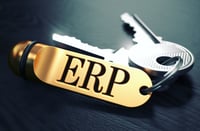 More than any other year prior, 2020 has highlighted the need for companies to look at business operations quite critically. Especially in light of the COVID pandemic, technology has become an essential part of the process of mobilizing the remote workforce and increasing collaboration.
More than any other year prior, 2020 has highlighted the need for companies to look at business operations quite critically. Especially in light of the COVID pandemic, technology has become an essential part of the process of mobilizing the remote workforce and increasing collaboration.
It’s no secret that digitalization can create efficiencies in your business. It could open up new revenue streams, and it can position you as a technological leader in your industry, depending on how “all-in” you choose to go. As much as the current economy may make you want to rush forward, there is value in starting slowly, creating a digital strategy, and making sure you have the fundamentals in place before your ERP implementation.
Focus on the Foundational Pillars
If you are considering making a move to digital and implementing an ERP, remember to keep customer experience, operational processes, and your business model top of mind when making your decision.
Customer experience: Without customers, you have no business, which is why your customer should always be at the heart of everything you do. Today’s business landscape is a lot more fast-paced, and customers are more demanding than before, with personalization and customization being the calls of the day. Manufacturers need to understand, profile, and categorize their customers. The right ERP can help by providing a socially informed, analytics-based segmentation of your customer base to service your customers better and more easily.
Operational processes: Operations are the foundation of any manufacturing business. By digitizing your processes, you can standardize your business processes and streamline operations. Microservices architectures or platforms, cloud enablement, and Software as a Service (SaaS) are the primary foundational technologies. These types of technology help manufacturers leverage collected IoT-driven data by connecting it to other tools and technologies, like predictive and cognitive analytics, artificial intelligence (AI), and machine learning (ML).
For these and other technologies to be truly transformative, however, they must be able to integrate with your ERP implementation and other enterprise applications.
Your business model: If you’re on a digital transformation journey, you may also need to consider making the transition to the cloud. Whether you run a solution on your premises, in a private or public cloud, or via a hybrid solution, the ability to access critical information anytime, from anywhere, and scale up and down quickly in response to events, all within a more secure environment, creates a significant advantage. It opens the door for the kind of connectivity you will need as a full and active participant in the digital economy.
Make the Transition to Digital With a Future-Fit ERP Implementation
ERP provides the platform to automate, integrate, and digitize business processes. An effectively implemented ERP system offers multiple benefits to help with overall business performance and can assist your organization with its digital transformation. It is a cost-effective entry-point into digitalization and allows you to get the fundamentals of digitalization right before expanding into the more complex and costly technologies. It can also help you to automate and integrate core business processes, such as taking customer orders; scheduling operations; and keeping inventory records and financial data.
Correctly implemented, an ERP system can also provide intelligence, visibility, analytics, and efficiency across every aspect of a business. This enables employees to contribute at a higher level and make decisions from a well-informed position, fostering better communication and collaboration across the business.
An ERP system implementation is more than just an IT project. It is a business-wide strategy to unlock multiple benefits for stakeholders. Its drivers and business objectives are firmly rooted in the business, and it has a significant impact on people, processes, and culture. Thus, it is crucial to have the right approach.
Before you choose an ERP software to implement, your end goal must be clearly defined and understood. You need to know what specific measurable benefits the system must deliver, manage stakeholder expectations, and gauge whether your various stakeholders (including your employees, management, and customers) are happy with the delivered outcomes.
It is critical to understand that your implemented ERP solution requires ongoing attention, oversight, and support throughout its life cycle. Without the correct level of attention and maintenance, the system won’t work effectively. When selecting an ERP provider, look for a vendor that offers both technology and delivery as a service, and will be part of the entire customer service cycle as a trusted advisor.
Start With the Basics
By getting the basics of your ERP implementation right, you are more likely to be successful in your digital transition journey. It is essential to perform due diligence and carefully consider the reasons for digitally transforming your business with an ERP implementation and other technology. Having a clear line of sight into your current state of readiness, your current operational processes, and the potential cost implications of transitioning is important. Otherwise, the transition could cost you more than the benefits it offers. By making sure you have a strong foundation, you can help your business to become more agile, efficient, innovative, and ready to embrace the opportunities that digitalization presents.
Get started with the right ERP implementation partner. For nearly 20 years, PositiveVision has been providing organizations with sales, support, training, and development services for world-class ERP software solutions, including Sage and SYSPRO. Leverage our expertise to ensure your ERP implementation goes as smoothly as possible to promote your digital transformation. Talk to an implementation expert now.


 © 2019 PositiveVision • 219 E. Thorndale Ave. Roselle, IL 60172
© 2019 PositiveVision • 219 E. Thorndale Ave. Roselle, IL 60172